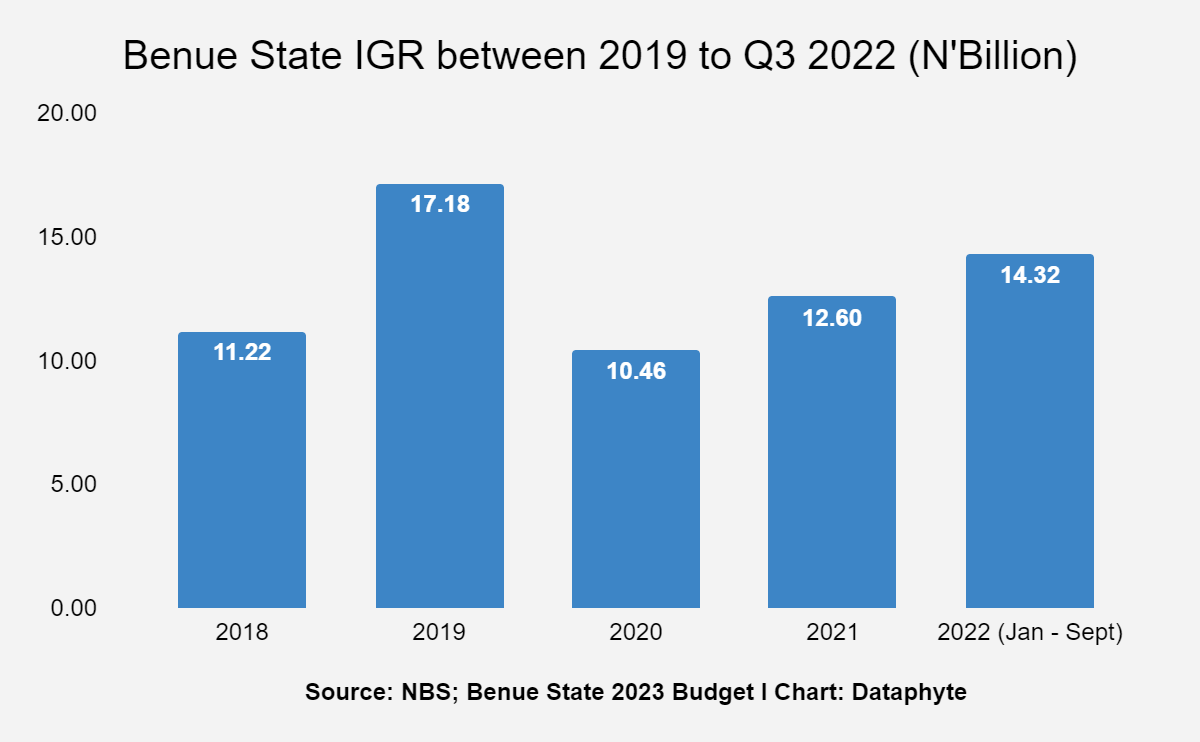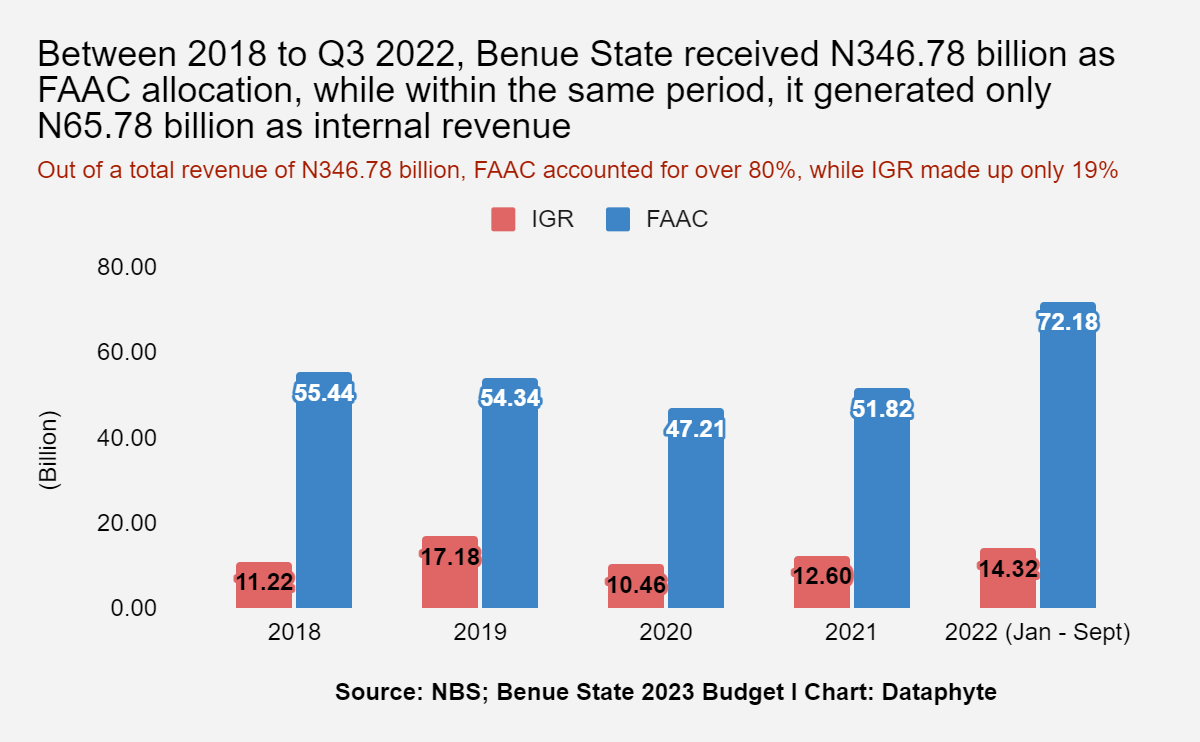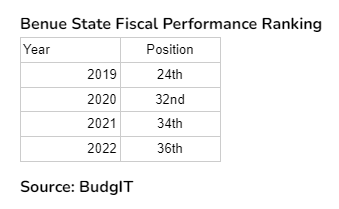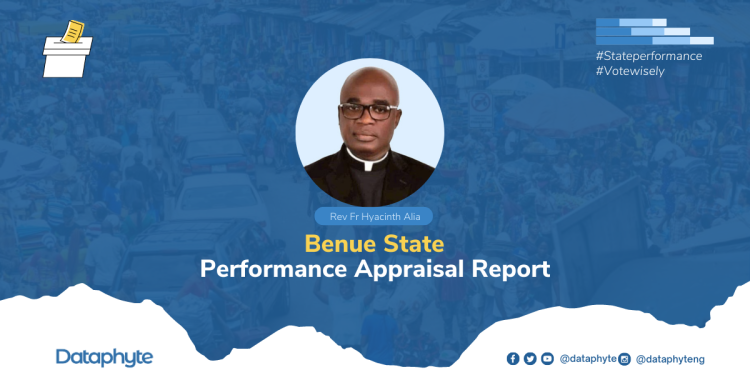About two weeks ago, the Dataphyte team was in Benue State for the wedding ceremony of one of its Senior Analysts.
For some of us, it was our first time visiting Benue State, the famed food basket of the nation. Although our stay was short, we still made out time to tour Makurdi, the state capital, and enjoyed some of the best barbecue.
But beyond the merriment, we had conversations about the socio-economic state of the state, which has an estimated population of 6.67 million.
While we may not be able to speak authoritatively about the socio-economic state of Benue State from just our short stay and tour around the state capital alone, data gives us a glimpse into the current state of certain socio-economic indicators in the state and the need for the current government to pay attention to these indicators.
Besides, this analysis marks the governance springboard of the new governor of the state, Rev Fr Hyacinth Alia. It provides a point of reference for his performance in years to come.
GDP, IGR & Fiscal Sustainability
GDP
First, let’s start by looking at the size of the economy of Benue State. By this, we mean the size of the state’s Gross Domestic Product (GDP).
GDP is the total monetary or market value of all the finished goods and services produced within a country’s borders in a specific time period. It calculates all the economic activities carried out within a year in an area.
According to BudgIT’s 2022 State of States report, Benue state has an estimated GDP of N4.27 trillion, the second state with the largest GDP in the North-Central region, just below Niger State.
.png)
Out of the 36 states, Benue has the 12th largest GDP.
On a per capita basis, the state tops others in the North-Central region. Dataphyte’s analysis shows that the state has a GDP per capita of N698,241
.png)
Although the state leads its counterparts, particularly in the North-Central region, the GDP per capita is relatively low compared to the majority of the states in the South-South and South-West region of Nigeria. Thus, there is a need for improvement as this would raise the standard of living of the people of Benue State, given that a higher GDP per capita generally indicates a higher standard of living for the population.
IGR
Another indicator to examine is the revenue-generating power of the state. Perhaps, this might be the most important indicator for many people in Benue State because it demonstrates the state’s financial strength and capacity to drive long-term economic activity, such as boosting employment and offering effective public services.
As Dr Princewill Okwoche, an economics lecturer at Benue State University, puts it, it is what provides the government with the resources to make responsible decisions that are needed to satisfy the basic needs of citizens in the state.
A review of the state’s internally generated revenue (IGR) from 2019 to half-year 2022 shows that a lot of work is cut out for the current administration in the state.
In 2018, the state generated a total IGR of N11.22 billion. The following year, it increased by 53% to N17.18 billion.

However, in 2020, the internal revenue generated by the state dropped to N10.46 billion, even lower than it was in 2018. This was not unconnected to the impact of the coronavirus, which the Executive Chairman of Benue Internal Revenue Service, BIRS, Mr. Andrew Ayabam, alluded to.
The following year, the IGR of the state went up to N12.60 billion, indicating some recovery from the impact of COVID-19, which affected the revenue the previous year.
The 9-month data on the internal revenue generated by the state in 2022 showed further recovery. The state generated a total of N14.32 billion within this period. This is an average of N1.59 billion monthly.
Suppose the same momentum was maintained till the last quarter of the year. In that case, the state might likely surpass its 2019 IGR of N17.18 billion when the full-year data is published because analysis of the 2019 IGR showed that Benue State generated an average of N1.43 billion monthly in 2019. Meanwhile, 9-month data for 2022 showed an average of N1.59 billion monthly.
While this improvement is good for the state, more work still needs to be done because compared to its counterpart, especially those in the North-central region, the state’s revenue is relatively small.
.png)
Moreso, Benue State’s reliance on federal allocation for survival is still on the high side.
Every month, the Federation Account Allocation Committee (FAAC) disburses funds among Nigeria’s three tiers of government. The disbursed funds are a collection of the government revenue generated from tax, oil sales, and other statutory sources in the previous month.
This disbursement now accounts for a significant part of many states’ revenue. Although ideally, it is not meant to be so because it puts them in a precarious situation because, in the event that there is a considerable cut in allocations, such a state may struggle to meet its essential obligations, such as payment of salaries, wages, pensions, and even providing other critical social services and infrastructures.
Sadly, Benue State is among the states in Nigeria that depend heavily on FAAC allocations. In fact, in 2021, BudgIT noted that Benue was the 4th most FAAC-dependent state in Nigeria.
According to the National Bureau of Statistics (NBS) and the Benue State government data, Benue State had a total revenue (i.e., IGR plus FAAC allocation) of N346.78 billion between 2018 to Q3 2022.

Of N346.78 billion, FAAC allocation accounted for as high as 81.03%, while IGR made up just 18.97%, indicating an increased reliance on FAAC disbursement.
Given this, the Hyacinth Alia administration will need to pay attention to this trend and explore options that can potentially increase the state’s internal revenue and reduce its heavy dependence on FAAC allocation.
In addition, the current administration will also give similar attention to improving its fiscal sustainability, as its ranking has been abysmal.
Fiscal Sustainability
Fiscal sustainability is the ability of a government to sustain its current spending, taxation, and other policies without risking its financial stability or failing to meet its obligations or promised expenses.
In the last six years, BudgIT has assessed the fiscal sustainability of all 36 states in Nigeria using indices such as the ability of the state to cover its operating costs solely with its IGR, its ability to meet all operating expenses and loan repayment obligations without resorting to borrowing, its debt sustainability, and its emphasis on capital expenditures over recurrent costs.
In the 2022 fiscal performance ranking, Benue was last among the 36 states.
While the 2022 ranking is, of course, its worst, its ranking in the previous years were not encouraging either.

The state has consistently ranked among the worst-performing states in the country in terms of fiscal performance. Thus, the current administration may need to take more deliberate steps, which include more disciplined spending to help improve the state’s fiscal sustainability.
This will also extend to its borrowings. BudgIT classified the state among those with low fiscal bandits to borrow, given their debt-to-revenue ratio, debt-to-GDP ratio, debt service-to-revenue ratio, and personnel cost-to-revenue ratio.
According to the data from the Debt Management Office (DMO), as of the end of 2022, Benue State had a total domestic of N141.29 billion, ranking as the 13th state with the most domestic debt. In the North-central region, it’s the second most indebted state.
A review of the state’s debt profile reveals an annual increase in the state’s domestic debt. From N98.73 billion in 2019, the state’s domestic debt increased to N141.29 billion in 2022.
.png)
The external debt, however, has declined slightly. From $33.42 million in 2019, it reduced to $29.94 million at the end of 2022, making it the 6th state in Nigeria with the lowest external debt.
.png)
While among its peers in the North-central region, it has the smallest foreign debt.
Unemployment rate
What is the unemployment rate like in Benue State? In the 2020 unemployment report, the NBS classified those within the labour force who were completely inactive, that is, those who did not work at all, and those who worked less than 20 hours per week as unemployed.
According to the 2020 data from NBS, which is the latest, there were 2.83 million persons in the labour force in Benue State. Of this, 339,311 were unemployed, representing a 12% unemployment rate, the second lowest in the country after Osun State.
In 2018, the unemployment rate was higher than this. It was pegged at 20% and ranked the 13th state with the lowest unemployment rate then. In both periods under review, Benue State’s unemployment rate was the lowest among its peers in the North-Central region.
While the latest data showed a reduction in the unemployment rate in the state, it is essential to note that since 2020, the NBS has not published any unemployment data, which means it may likely not represent the current reality in the state.
Thus, there is a need for the current administration to match actions with words to create job opportunities in the state as well as a favourable business environment to attract investors and make the existing ones thrive.
Interestingly, during his inaugural speech in May, the state Governor, Hyacinth Alia, promised to prioritise job creation and a favourable business climate.
“We will prioritize job creation and economic empowerment by promoting private sector-led industrialization, with a particular emphasis on agriculture. We will also work to improve the business environment in the state by enacting investor protection laws and streamlining procedures to make it easier to do business in Benue State,” Alia said.
Poverty rate
Unemployment and underemployment, according to the United Nations (UN) remain the core of poverty. This appears obvious in Nigeria, and Benue State is no exception.
Last year, the NBS released its National Multidimensional Poverty Index (MPI) report. The report revealed that 75% of the Benue State population is dimensionally poor. By this, it means that 75% of the people in the state lack access to either good health, education, living standards, or work and shocks because the NBS measured multidimensional poverty using these indicators.
.png)
Source: Multidimensional Poverty Index (MPI) Report
The 2019 NBS report, which focused majorly on finance (an actual per capita expenditure of N137,430 per year or N376.50 per day) as the determinant of poverty, pegged the poverty rate in the state then at 32.9%.
This clearly shows a high jump in the state’s poverty rate. Also, the current poverty rate places the state as the second with the highest poverty rate in the North-Central region and the 12th nationally.
Number of Out-of-School Children
The number of out-of-school children in the state equally requires the government’s attention.
The NBS out-of-school children data that was published in 2018 shows that 252,037 children in Benue State lack access to education. Girls accounted for 55% of the number, while boys made up the remaining.
.png)
Since then, the NBS has not released any data on the number of out-of-school children in Nigeria. Thus, we may not be able to estimate the current number. However, there are concerns that the number would have increased significantly owing to different factors. For instance, in May 2023, the Benue State Commissioner for Education, Tarnongo Saawuan, said that over 30 primary and 10 secondary schools in the state were closed down in rural communities as a result of armed invasions. This will likely result in putting children away from school, increasing the number of children who lack access to education in the state.
Moreover, in 2022, the United Nations Educational, Scientific and Cultural Organisation (UNESCO) stated that the number of out-of-school children in Nigeria has risen to 20 million. With this national increase in the number of out-of-school children, Benue State is likely to experience a corresponding increase.
Thus, the Hyacinth Alia administration has some work cut out for him in this regard, both in the aspect of developing policies that would ensure access to quality education and addressing security challenges that have now become a major threat to education in the state.
Ease of Doing Business Ranking
Undoubtedly, the business environment in a country or state plays a vital role in attracting both local and international investments to the location.
In this regard, Benue State’s ranking is below average. In fact, the recent ease of doing business ranking by the Presidential Enabling Business Environment Council (PEBEC) shows a decline in the state’s ranking.
In 2021, the PEBEC used four indicators, namely Infrastructure and Security, Transparency and Access to Information, Regulatory Environment, and Workforce Readiness, to assess the business environment in the 36 states and Federal Capital Territory (FCT).
From the assessment, Benue State ranked 16th place with a score of 5.56 out of a total index score of 10. Apart from the Plateau State, Benue fared better than the other states in the North-Central region on this indicator.
.jpg)
But the 2023 ranking showed that the business environment in Benue State has deteriorated. The state now ranks as the 23rd state in the ease of doing business ranking, a drop from its 16th position in 2021.
This signals a need for the current government to take actions that will improve the business environment, as the Governor rightly said during his inaugural speech in May.
Under-5 Mortality Rate
The last indicator we will examine is the under-5 mortality rate in the state.
Under-five mortality refers to the probability of a child dying between birth and their fifth birthday. In 2018, the average under-5 mortality rate in Nigeria was 132 deaths per 1,000 live births. That is, 132 out of every 1,000 children born would die before age 5.
In Benue State, the mortality rate was pegged at 59 deaths per 1,000 live births, placing it among the 6 states with the lowest rate then.
The Multiple Indicator Cluster Survey that was released in 2022 showed progress on this indicator.
According to the report, under-5 mortality in Benue State now stands at 42 deaths per 1,000 live births, indicating an improvement.
While this progress is impressive, the current administration would need to consolidate this effort and further reduce the under-5 mortality rate in the state, as well as neonatal mortality.
Overall, the state, through its current administration, needs some pinpoint fiscal policies that will increase its revenue generation commensurate to its economic size. This will improve the fiscal sustainability of the state and improve its economic position of the state and rub on other socio-economic indices.



.png)
.png)

.png)


.png)
.png)
.png)
.png)
.jpg)